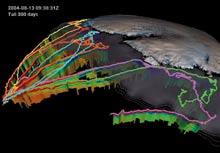Sea mammals could be severely affected by climate change. Now some of these creatures are helping scientists figure out the complex dynamics of global warming. The tracks in the image below represent data collected by sensors glued to the heads of elephant seals swimming near the coast of Antarctica. As part of a three-year project, the sensors transmitted information about changes in ocean temperature and salinity that are crucial to explaining global climate change. Researchers from an international team wired the seals up and then released them; each time the seals dived–as many as 60 times a day, as deep as 600 meters–the sensors collected data. In the image, colored lines represent the routes of specific seals, and the shaded areas represent temperature readings when they dived. When the seals resurfaced, the data was sent by satellite and Internet to the Sea Mammal Research Unit in St. Andrews, Scotland, and then to the National Oceanographic Data Center in the U.S. and the Coriolis center in France, where oceanographers relayed it to climate researchers. When the seals molted, they shed the equipment.

Keep Reading
Most Popular
Large language models can do jaw-dropping things. But nobody knows exactly why.
And that's a problem. Figuring it out is one of the biggest scientific puzzles of our time and a crucial step towards controlling more powerful future models.
How scientists traced a mysterious covid case back to six toilets
When wastewater surveillance turns into a hunt for a single infected individual, the ethics get tricky.
The problem with plug-in hybrids? Their drivers.
Plug-in hybrids are often sold as a transition to EVs, but new data from Europe shows we’re still underestimating the emissions they produce.
Stay connected
Get the latest updates from
MIT Technology Review
Discover special offers, top stories, upcoming events, and more.